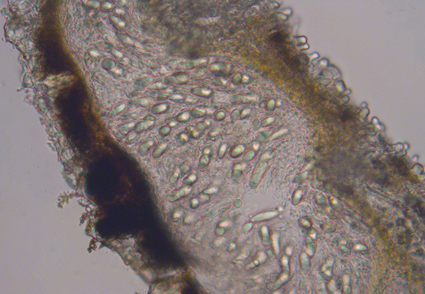Abstract
Thirty-seven Phyllachora specimens were collected in China and examined for morphological characteristics. A molecular phylogenetic analysis based on a combined sequence dataset of ITS and LSU was also undertaken. Phyllachora cephalostachyi sp. nov. on Cephalostachyum pergracile is described based on its distinct phylogenetic relationships and a comparison of its morphological characteristics with known Phyllachora species on bamboo. Our results indicate a high species diversity of Phyllachora on bamboo in China. A full description and colour photographs of micro-characters are provided for the new species. A phylogenetic tree to show placement of the new species, and a table to compare morphology of the Phyllachora species reported on bamboo are also provided.
References
<p>Cannon, P.F. (1991) A revision of <em>Phyllachora</em> and some similar genera on the host family Leguminosae. <em>Mycological Papers</em> 163: 1–302. https://doi.org/10.1071/APP9930111</p>
<p>Dayarathne, M.C., Maharachchikumbura, S.S.N., Jones, E.B.G., Goonasekara, I.D., Bulgakov, T.S., Al-Sadi, A.M., Hyde, K.D., Lumyong, S. & McKenzie, E.H.C. (2017) <em>Neophyllachora </em>gen. nov. (Phyllachorales), three new species of <em>Phyllachora </em>from Poaceae and resurrection of Polystigmataceae (Xylariales). <em>Mycosphere </em>8: 1598–1625. https://doi.org/10.5943/mycosphere/8/10/2</p>
<p>Doyle, J.J. & Doyle, J.L. (1987) A rapid DNA isolation procedure from small quantities of fresh leaf tissues. <em>Phytochemical Bulletin</em> 19: 11–15.</p>
<p>Hino, I. & Katumoto, K. (1955) Illustrationes fungorum bambusicolorum III. <em>Bulletin of the Faculty of Agriculture</em>, <em>Yamaguti University</em> 6: 29–69.</p>
<p>Katoh, K. & Standley, D.M. (2013) MAFFT multiple sequence alignment software version 7: improvements in performance and usability. <em>Molecular Biology and Evolution</em> 30: 772–780. https://doi.org/10.1093/molbev/mst010</p>
<p>Li, X.L., Yang, Z.X., Wang, X.X., Wang, Y. & Li, C.Y. (2018) Two new species of graminicolous <em>Phyllachora</em>. <em>Mycosystema </em>37: 1127–1132. https://doi.org/10.13346/j.mycosystema.180054</p>
<p>Li, X.L., Wu, S.R., Wang, C.L., Feng, Y.L., Zhao, C.Y., Chen, Z.Q., Yu, J.F., Luo, R., Promputtha, I. & Sun, D.F. (2019) Two new species of <em>Phyllachora </em>(Phyllachoraceae, Phyllachorales) on bamboo from China. <em>Phytotaxa</em> 425: 78–86. https://doi.org/10.11646/phytotaxa.425.2.2</p>
<p>Orton, C.R. (1944) Graminicolous species of <em>Phyllachora</em> in North America. <em>Mycologia</em> 36: 18–53. https://doi.org/10.2307/3754878</p>
<p>Parbery, D.G. (1967) Studies on graminicolous species of <em>Phyllachora </em>Nke. in Fckl. V. A taxonomic monograph. <em>Australian Journal of Botany</em> 15: 271–375. https://doi.org/10.1071/BT9670271</p>
<p>Parbery, D.G. (1971) Studies on graminicolous species of <em>Phyllachora</em> Nke. in Fckl. VI. Additions and corrections to Part V. <em>Australian Journal of Botany</em> 19: 207–235. https://doi.org/10.1071/bt9710207</p>
<p>Parbery, D.G. & Langdon, R.F.N. (1964) Studies on graminicolous species of <em>Phyllachora</em> Fckl. IV. Evaluation of the criteria of species. <em>Australian Journal of Botany </em>12: 265–281. https://doi.org/10.1071/BT9640265</p>
<p>Patouillard, N. (1914) Specific descriptor: megastroma. <em>Bulletin de la Société Mycologique de France</em> 30: 345–349.</p>
<p>Rambaut, A. (2012) Fig.Tree. Tree figure drawing tool. v. 1.4.0. Available from: http://tree.bio.ed.ac.uk/software/figtree/ (accessed 12 August 2021)</p>
<p>Rehm, H. (1914) Ascomycetes Philippineses–V. <em>Leaflets of Philippine Botany</em> 6: 2191–2195.</p>
<p>Rehner, S.A. & Samuels, G.J. (1994) Taxonomy and phylogeny of <em>Gliocladium</em> analysed from nuclear large subunit ribosomal DNA sequences. <em>Mycological Research </em>98: 625–634. https://doi.org/10.1016/S0953-7562(09)80409-7</p>
<p>Saccardo, P.A. (1902) <em>Sylloge Fungorum Omnium Hucusque Cognitorum</em>, vol. 16. Patavii, Italy.</p>
<p>Saccardo, P.A. (1905) <em>Sylloge Fungorum Omnium Hucusque Cognitorum</em>, vol. 17. Patavii, Italy.</p>
<p>Saccardo, P.A. (1926) <em>Sylloge Fungorum Omnium Hucusque Cognitorum</em>, vol. 24. Patavii, Italy.</p>
<p>Sawada, K. (1943) Descriptive catalogue of Taiwan (Formosan) fungi VIII. <em>Report Government Research Institute, Department of Agriculture Formosa</em> 85: 1–131.</p>
<p>Stamatakis, A. (2014) RaxML version 8: a tool for phylogenetic analysis and post analysis of large phylogenies. <em>Bioinformatics</em> 30: 1312–1313. http://dx.doi.org/10.1093/bioinformatics/btu033</p>
<p>Swofford, D.L. (2003) PAUP*: phylogenetic analysis using parsimony (*and other methods). Version 4.0b10. Sinauer Associates, Sunderland. https://doi.org/10.1111/j.0014-3820.2002.tb00191.x</p>
<p>Tai, F.L. (1979) <em>Sylloge Fungorum Sinicorum.</em> Science Press, Beijing.</p>
<p>Tamakaew, N., Maharachchikumbura, S.S.N., Hyde, K.D. & Cheewangkoon, R. (2017) Tar spot fungi from Thailand. <em>Mycosphere</em> 8: 1054–1058. https://doi.org/10.5943/mycosphere/8/8/6</p>
<p>Theissen, F. & Sydow, H. (1915) Die Dothideales. Kritisch-systematische riginaluntersuchungen. <em>Annales Mycologici </em>13: 147–746.</p>
<p>Thompson, J.D., Higgins, D.G. & Gibson, T.J. (1994) CLUSTAL W: improving the sensitivity of progressive multiple sequence alignment through sequence weighting, position-specific gap penalties and weight matrix choice. <em>Nucleic Acids Research</em> 22: 4673–4680.</p>
<p>Vilgalys, R. & Hester, M. (1990) Rapid genetic identification and mapping of enzymatically amplified ribosomal DNA from several <em>Cryptococcus</em> species. <em>Journal of Bacteriology</em> 172: 4238–4246. https://doi.org/10.1128/jb.172.8.4238-4246.1990</p>
<p>White, T.J., Bruns, T., Lee, S.J. & Taylor, J.L. (1990) Amplification and direct sequencing of fungal ribosomal RNA genes for phylogenetics. PCR protocols: a guide to methods and applications 18: 315–322. https://doi.org/10.1016/B978-0-12-372180-8.50042-1</p>
<p>Wu, J.W., Li, C.Y., Zhang, T., Zhang, L.Y. & Liu, L. (2013) Record of a new species of <em>Phyllachora</em>. <em>Journal of Yunnan Agricultural University</em> 4: 590–591.</p>
<p>Yang, C.L., Xu, X.L., Liu, Y.G., Hyde, K.D. & McKenzie, E.H.C. (2019) A new species of <em>Phyllachora </em>(Phyllachoraceae, Phyllachorales) on <em>Phyllostachys heteroclada</em> from Sichuan, China. <em>Phytotaxa</em> 392: 186–196. https://doi.org/10.11646/phytotaxa.392.3.2</p>
<p>Zhang, Z.Y. & Zhang, T. (2014) <em>Flora Fungorum Sinicorum.</em> Vol. 46: <em>Phyllachora</em>. Science Press, Beijing.</p>


